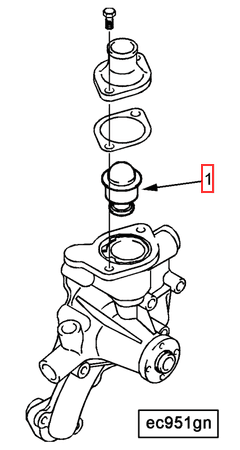Introduction
The Cummins 4900260 Thermostat is a component designed for use in commercial trucks. Its purpose is to regulate the engine’s temperature, ensuring it operates within a specified range. This regulation is vital for the efficient functioning of the engine and for protecting it from potential damage due to temperature extremes 1.
Basic Concepts of a Thermostat
A thermostat is a device that senses the temperature of a fluid and controls the flow of that fluid to maintain the temperature at or near a set point. In an engine cooling system, the thermostat plays a role by regulating the flow of coolant between the engine and the radiator. When the engine is cold, the thermostat remains closed, preventing coolant flow and allowing the engine to warm up quickly. Once the engine reaches the optimal operating temperature, the thermostat opens, allowing coolant to circulate and maintain that temperature 2.
Purpose of the Cummins 4900260 Thermostat
The Cummins 4900260 Thermostat is designed to maintain the engine’s optimal operating temperature. By regulating the flow of coolant, it ensures the engine operates efficiently and reduces the risk of damage from overheating or underheating. This regulation is particularly important in commercial trucks, where engines are subjected to varying loads and operating conditions 3.
Key Features
The Cummins 4900260 Thermostat incorporates several design and construction features that enhance its performance and reliability. These include the use of durable materials resistant to corrosion and high temperatures, precise sealing mechanisms to prevent coolant leaks, and accurate temperature control to ensure consistent engine temperature regulation.
Benefits of Using the Cummins 4900260 Thermostat
Using the Cummins 4900260 Thermostat offers several advantages. It contributes to improved engine efficiency by ensuring the engine operates at its optimal temperature. This can lead to better fuel economy and reduced emissions. Additionally, by maintaining consistent engine temperatures, the thermostat helps extend the engine’s life and ensures reliable performance under a wide range of operating conditions.
Installation Considerations
When installing the Cummins 4900260 Thermostat, it is important to follow guidelines and best practices to ensure proper function. This includes using the correct torque specifications for fastening the thermostat housing, ensuring proper sealing to prevent coolant leaks, and verifying compatibility with the specific engine model to ensure optimal performance.
Troubleshooting Common Issues
Common issues with thermostats include sticking in the closed or open position, which can lead to engine overheating or underheating. Diagnostic steps may involve checking the thermostat’s operation by monitoring engine temperature or conducting a coolant flow test. Solutions may range from cleaning the thermostat to replacing it if it is found to be faulty.
Maintenance Tips
Regular maintenance of the Cummins 4900260 Thermostat is important for ensuring its longevity and optimal performance. This includes periodic inspection for signs of wear or damage, checking for proper operation, and following manufacturer guidelines for replacement intervals. Proper maintenance helps prevent unexpected failures and ensures the engine continues to operate efficiently.
Cummins Overview
Cummins Inc. is a global power leader that designs, manufactures, and distributes engines, filtration, and power generation products. With a history spanning over a century, Cummins has established a reputation for quality and reliability in the commercial truck industry. Its product range includes a variety of engines and components designed to meet the demanding requirements of commercial applications.
Role of Part 4900260 Thermostat in Engine Systems
The part 4900260 thermostat is an essential component in maintaining the optimal operating temperature of an engine. It works in conjunction with several other components to ensure efficient engine performance and longevity.
Interaction with the Cooling System
- Radiator: The thermostat regulates the flow of coolant between the engine and the radiator. When the engine is cold, the thermostat remains closed, preventing coolant from flowing to the radiator. As the engine warms up, the thermostat opens, allowing coolant to circulate and be cooled by the radiator.
- Water Pump: Driven by a belt connected to the engine, the water pump circulates coolant through the engine and to the radiator. The thermostat controls when this circulation begins, ensuring the engine reaches its optimal operating temperature as quickly as possible.
Engine Components
- Cylinder Block: The thermostat helps maintain a consistent temperature within the cylinder block, which is vital for the metal’s structural integrity and the efficiency of the combustion process.
- Cylinder Head: Proper temperature regulation by the thermostat prevents overheating, which can lead to warping of the cylinder head and subsequent loss of compression.
- Pistons and Rings: Consistent engine temperature ensures that pistons and rings maintain their proper clearances, reducing wear and improving engine efficiency.
Additional Systems
- Heater Core: The thermostat indirectly affects the vehicle’s heating system. By regulating engine temperature, it ensures that the heater core receives warm coolant, providing efficient cabin heating.
- Temperature Sensor: Many modern engines are equipped with temperature sensors that monitor coolant temperature. The thermostat’s role in maintaining consistent temperature aids in the accurate readings of these sensors, which are used by the engine control unit (ECU) to make adjustments for optimal performance.
Conclusion
In summary, the Cummins 4900260 Thermostat plays a significant role in the thermal management of an engine, interacting with various components to ensure efficient operation and longevity. Its design and features contribute to improved engine efficiency, extended engine life, and reliable performance under a wide range of operating conditions.
SPECIFICATIONS
RECOMMENDED PARTS
* Variable geometry turbocharger and electronic actuator repairs are not eligible to be claimed as over-the-counter under New or ReCon parts warranty for parts installed after October 1, 2018.
* Diesel Oxidation Catalyst (DOC), Diesel Particulate Filter (DPF), Selective Catalyst Reduction (SCR) catalyst, and Electronic Control Module (ECM) repairs are not eligible to be claimed as over-the-counter under New or ReCon parts warranty for parts installed after January 1, 2020.
* These restrictions are only applicable to New parts and ReCon parts coverages for the components listed above sold to a customer in the US or Canada. All other coverages are excluded. All other regions are excluded.

